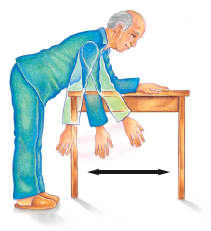Pendulum Exercise for Use with Shoulder Repair Surgeries
Pendulum Exercise for Use with Shoulder Repair Surgeries
Stretching exercises for your shoulder, such as the pendulum exercise, can improve flexibility, increase range of motion, and reduce pain. Your healthcare provider or physical therapist has recommended the pendulum exercise to help speed your recovery. Remember to breathe normally when you exercise and try to use smooth, fluid movements.
Doing the pendulum exercise
Follow any special instructions you were given. If you feel pain, stop the exercise. If the pain continues after stopping, call your healthcare provider or physical therapist.
Start pendulum exercises with your affected arm as soon as directed by your healthcare provider:
Lean over with your good arm supported on a table or chair.
Relax the arm on the painful side, letting it hang straight down.
Slowly begin to swing the relaxed arm by moving your body. Move it in a circle, then reverse the direction. Next, move the arm backward and forward. Finally, move it side to side.
Let gravity gently sway your arm. Do not actively lift or move it with your shoulder muscles.
Do the exercise 3 times a day, for 5 to 10 minutes each time, or as directed by your healthcare provider. Change the direction of your movement after 1 minute of motion.
Home care
Wear your sling as directed.
Use pain medicine as directed by your healthcare provider.
Follow-up care
Make a follow-up appointment with your healthcare provider, or as advised.
Call 911
Call 911 right away if you have:
Chest pain
Shortness of breath
When to call your healthcare provider
Call your healthcare provider right away if you have:
Fever of 100.4°F (38°C) or higher, or as directed by your healthcare provider
Shaking chills
Increasing shoulder pain
Pain that is not relieved by medicine
Pain or swelling in the arm on the side of your surgery
Numbness, tingling, or blue-gray color of your arm or fingers on the side of your surgery
Increased swelling or redness around the incision
Drainage or oozing around the incision
Updated:
September 04, 2017
Reviewed By:
Joseph, Thomas N., MD,Moloney Johns, Amanda, PA-C, MPAS, BBA
